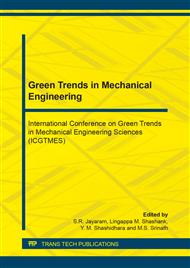p.96
p.102
p.109
p.115
p.122
p.127
p.134
p.139
p.144
Experimental Investigations on Vibration Properties of Aluminium Matrix Composites Reinforced with Iron Oxide Particles
Abstract:
Aluminium matrix composites offer improved damping properties than other metals and its alloy. Generally pure metals and its alloys may have fairly good mechanical properties but falls short in damping properties. Aluminium matrix composites are becoming important in aerospace automobile and marine applications due to its god damping properties. The present investigation is concerned with the damping capacity of iron oxide (Fe2O3) reinforced aluminium matrix composite. The composites were fabricated with 2%, 4% and 6%, by weight of iron oxide with varied particle of size 40 μm and 500 nm in equal proportions using stir casting process. From the results obtained the 500 nm size with 4 wt% of iron oxide showed improved dynamic properties. The iron oxides reinforced with aluminum matrix are found to be new substitutes for the existing materials with low damping properties.
Info:
Periodical:
Pages:
122-126
Citation:
Online since:
November 2019
Authors:
Keywords:
Price:
Сopyright:
© 2019 Trans Tech Publications Ltd. All Rights Reserved
Share:
Citation:


